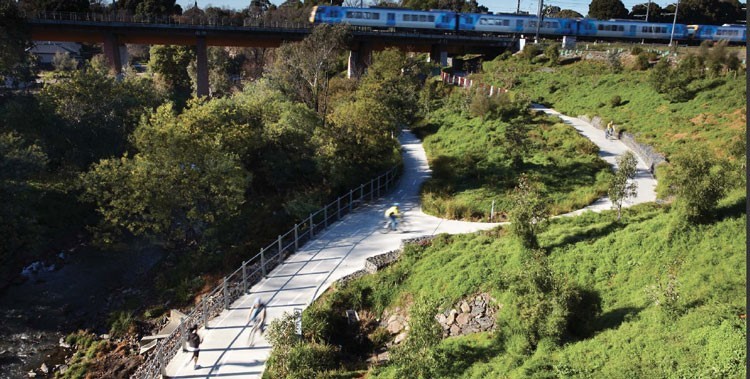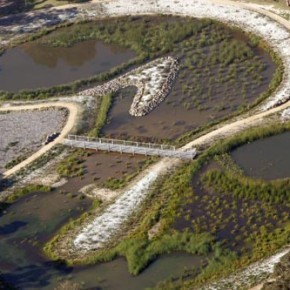Urban design to enhance green space habitat values and mitigate urban impacts on ecosystems
These are examples of ecological design within urban green space where ecosystem recovery work and design are combined to satisfy both biodiversity and human values.
Individual components of this environmental network
are sometimes referred to as 'green infrastructure assets' (see
footnote), and these occur across a range of landscape scales - from
residential gardens to local parks and housing estates, streetscapes and
highway verges, services and communications corridors, waterways and regional
recreation areas etc.
Examples provided below: Lollipop Creek
| Clifton Hill Railway Project Landscape | Royal
Park Wetland
Lollipop Creek, Melbourne
The Lollipop Creek master plan recognises the loss of natural grasslands on the western plains of Melbourne and adopts a pragmatic and evidence-based response. The Lollipop Creek master plan retains natural rocky outcrops and other features of the interface area, minimises new disturbance and applies contemporary best practice in weed-control and grass management to stimulate regeneration of indigenous species. The use of ecological and fuel-reduction burning rarely occurs this close to new urban development, but forms an integral part of the success of the land management program.
Data collected as part of the project confirms improved biodiversity and habitat value through increased cover of native herbs and small shrubs and a marked decrease in weed coverage.
Designers: Fitzgerald Frisby Landscape Architecture. Managers: Devine Communities.
Clifton Hill Railway Project Landscape
a design, the Clifton Hill Railway Project Landscape overcomes the challenges of unifying a long and linear site with multiple level changes to achieve an accessible path through revegetated creekland. Ecologically sensitive planting reflects the character of the site and the materials are recycled, salvaged and robust. Travel along the path is punctuated by nodes giving the user a reason to stop and recreate in a previously derelict and abandoned space.
Designers: Jeavons Landscape Architects.Managers: Department of Transport (Victoria).

Royal Park Wetland

Royal Park
is central Melbourne's largest inner city parks; its size, location and
design make a significant contribution to Melbourne's garden character,
sporting heritage and its Victorian legacy. In 1998, The City of Melbourne
adopted the Royal Park Masterplan which included the development of a
wetland system for storm water recycling and harvesting as a key component.
The wetlands were officially opened on in June 2006 as Trin Warren Tam-boore
(Bellbird waterhole).
The project is significant as an innovative combination of engineering,
ecology and community engagement which has created a unique landscape
and water management outcome in a high profile city park. The wetlands
system consists of two linked ponds that provide natural water quality
treatment and the storage of treated stormwater captured from the park
and its surrounding catchment. Recycled water is then used for irrigation
in Royal Park with excess clean water discharged to Moonee Ponds Creek
and Port Phillip Bay. The treatment wetland and its adjoining landscape
is intended to create an artificial billabong environment, focusing on
providing educational, interpretive and passive recreation opportunities
focused on environmental understanding. The storage wetland provides an
open water lagoon from which water is sourced for irrigation of the parklands.
Designers: Ecological Engineering. Managers: City of
Melbourne.
Footnote: The term 'green infrastructure'
describes the network of natural landscape assets which underpin the economic,
socio-cultural and environmental functionality of our cities and towns,
i.e. the green spaces and water systems which intersperse, connect and
provide vital life support for humans and other species within our urban
environments. See: http://www.aila.org.au/imis_prod/documents/AILA/Advocacy/National
Policy Statements/AILA Green Infrastructure.pdf